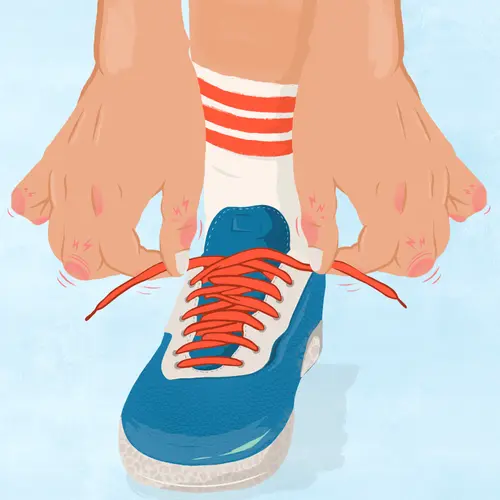Having rheumatoid arthritis doesn’t give you a pass to escape working out. In fact, regular exercise can keep your joints and muscles strong. It can also improve your heart health. That’ll make you better equipped to deal with complications that may crop up.
Other benefits of regular exercise include:
- Less pain
- More stability in your joints
- More energy
- Improved physical function and performance
- Better bone health
- Improved quality of life
Stretches
To ease joint stiffness and widen your range of motion, you need to stretch your muscles. Morning is a good time for gentle stretching or yoga. It’s also a good idea any time before exercise.
Leg/hamstring stretch: While standing, lean forward as far as you comfortably can and reach toward your toes. Make sure you bend your knees a little to keep your legs soft. Hold it for 10-20 seconds.
Finger/wrist stretch: Bend your fingers forward, then backward, holding each stretch for 10–20 seconds each time. Then do the same with your hand to stretch your wrist muscles.
Cross-body arm stretch: Put your arm across the front of your body and gently hold it for 10-20 seconds, then switch to the other arm. Next, reach up to the sky with one arm and then the other, tilting each arm slightly over your head to stretch your shoulders.
Neck stretches: Drop your head forward gently, and then roll it slowly toward one shoulder and back toward the other.
Yoga Poses
Cobra: Lie face-down on the floor, keeping your toes pointed away from you. Press your palms into the floor and slowly raise your upper body. Keep your elbows close to your side.
Extended leg balance: While standing, put all your weight on one foot. Use a chair or table for support and slowly lift your leg and hold it with one leg on the outside of your knee. For an even better stretch, rotate your leg out to the side from that position and hold.
Seated spinal twist: Sit up tall in a chair and put your hand on the outside of the opposite thigh. Gently twist in the direction of your arm and hold. Then, switch to the other side.
Strength Exercises
RA can slowly take away muscle mass. So, it’s important to work out your muscles to help them stay strong.
If you have swollen joints, you can do isometric exercises. They hold your muscles in one place. They also don’t make you move your joints.
If your joints aren’t swollen, isotonic exercises (movements that work against resistance, like weightlifting) are good for building up muscles.
Talk to your doctor before you start any kind of strength training.
Abdominal contractions: To do this isometric exercise, lie on your back and put your hands on your stomach muscles. Lift your head and hold it. You can continue this exercise by squeezing the muscles that lifted your head without actually picking it up, too.
Palm press: This is isometric, too. Hold your hands so they face each other. One hand should have fingertips up and the other should have fingertips down. Press your palms together and hold.
Bicep lifts: While you sit in a chair with your arms resting on your thighs palms up, hold light weights in your hands. Then, raise them toward your shoulders, bending at the elbow.
Seated knee lift: With a resistance band over your legs in a seated position, raise one leg slowly, then switch sides.
Exercises for Endurance
Your heart muscle needs a workout just like your biceps or quads do. Aerobic exercises raise your breathing and heart rates. Your best bets are exercises that get your blood pumping and are easy on your joints.
Walking: Daily walks are an easy way to get into the exercise groove. Start with slow and short strolls if you’re new to regular exercise. Then work up to longer, faster walks as you get stronger. Be sure to stretch before you start and after you finish. Drink plenty of water, too.
Cycling: A stationary bike takes away your risk of a fall. Again, start slowly if you’re a beginner, and go faster as you get better.
Swimming: Water workouts are great when you have RA. They take weight off your joints. They also raise your heart rate. Water also acts as resistance against your muscles. That can make you stronger.
You can swim laps or join a water aerobics class. Use water weights for some more muscle work.

